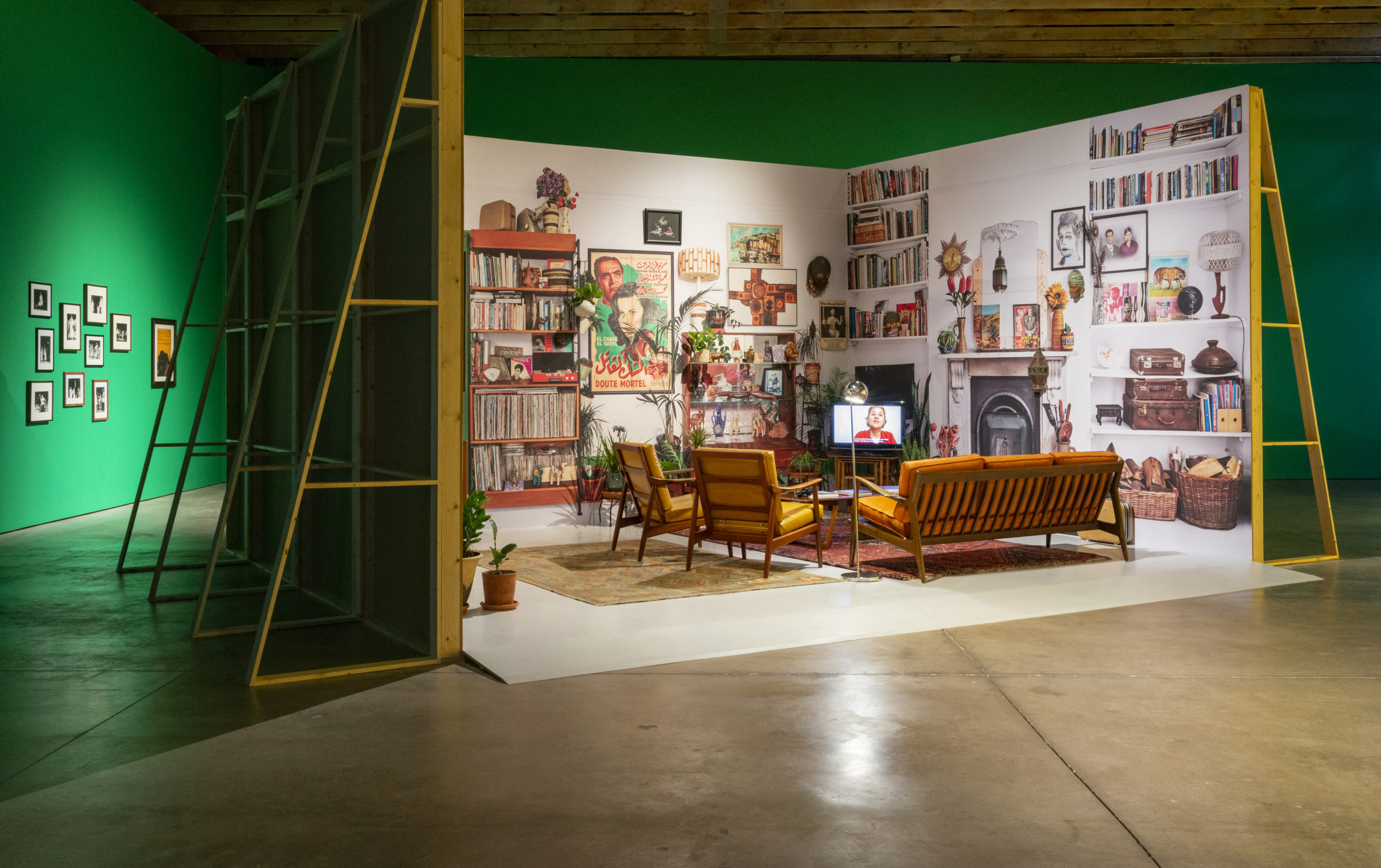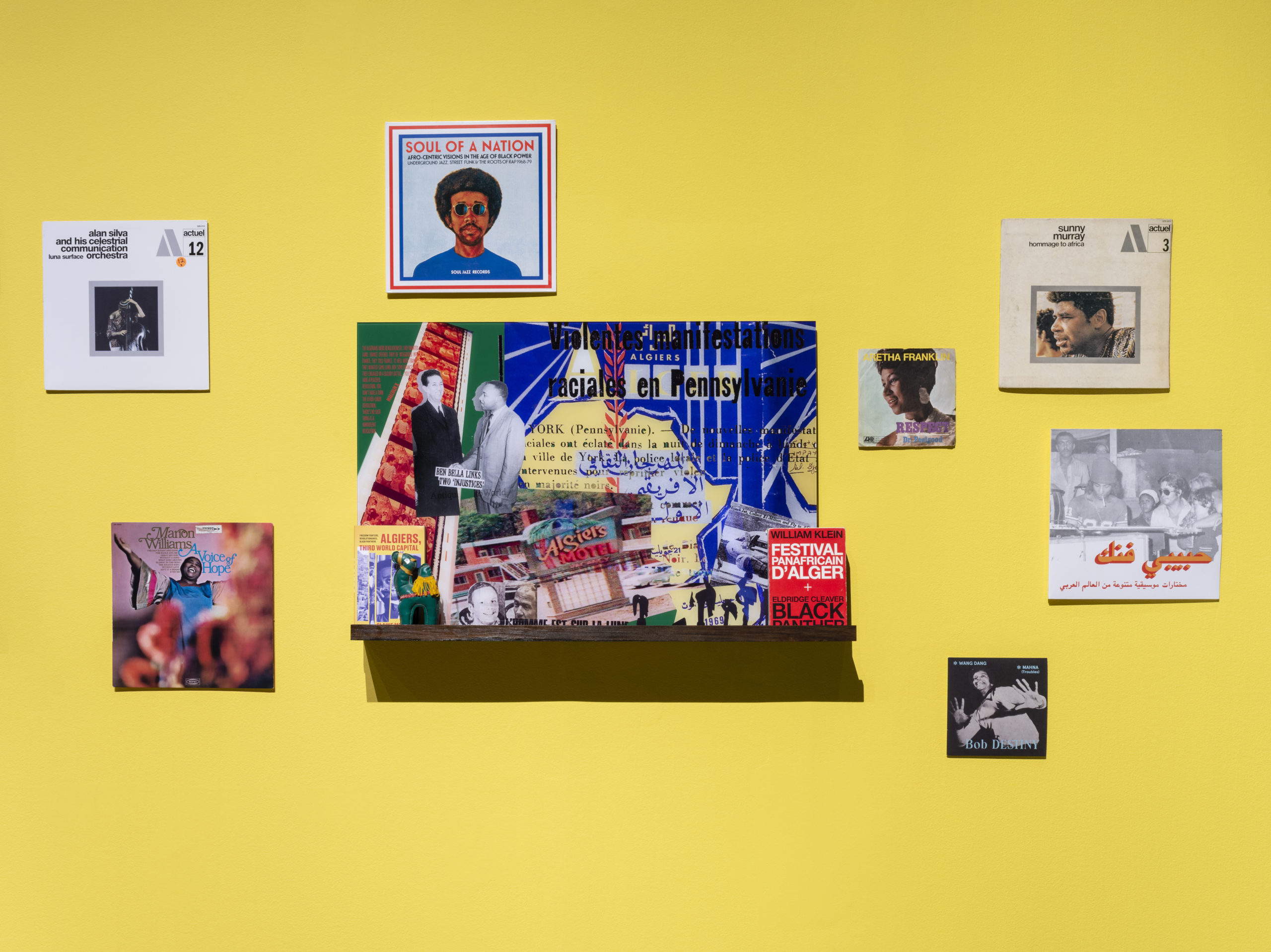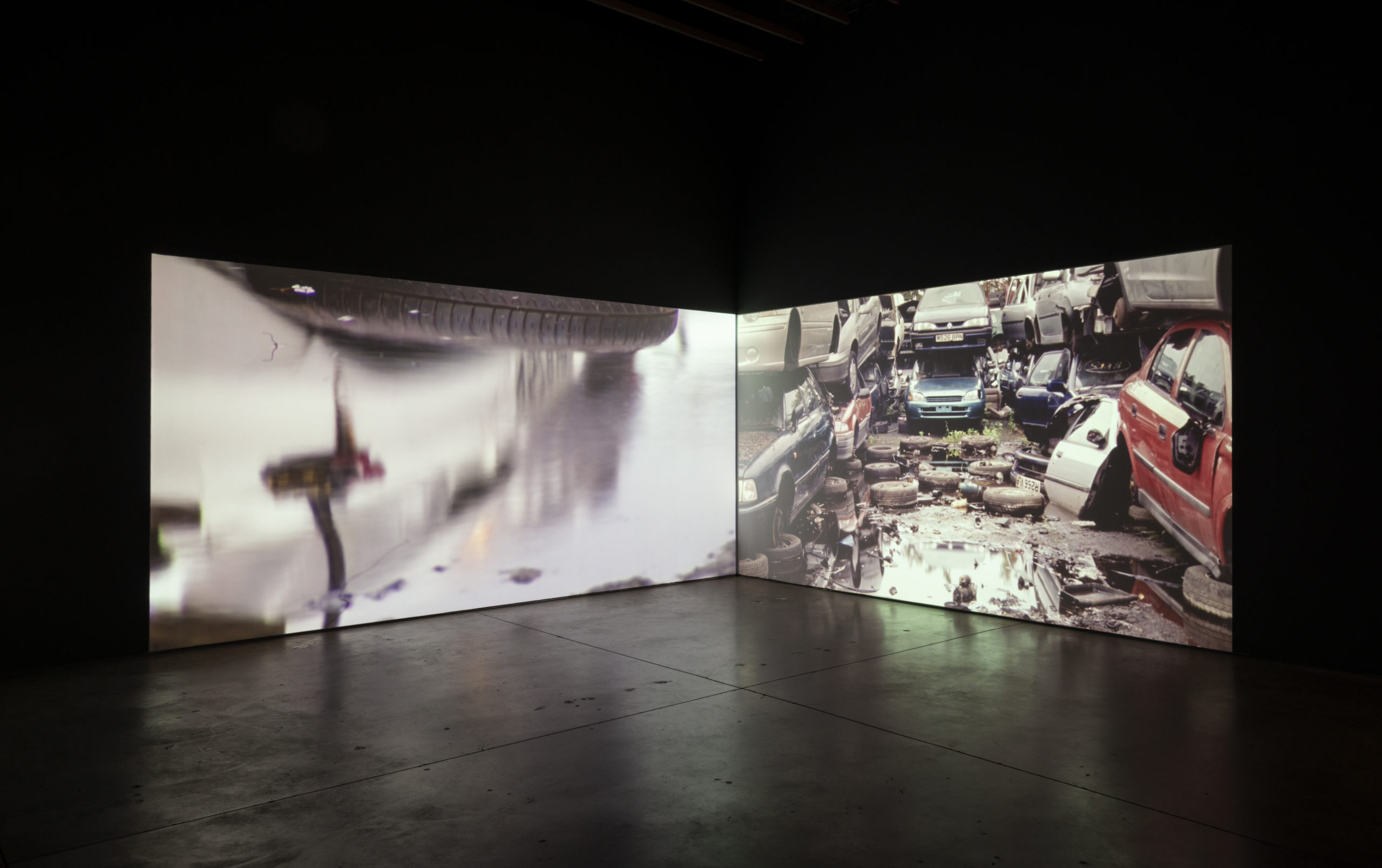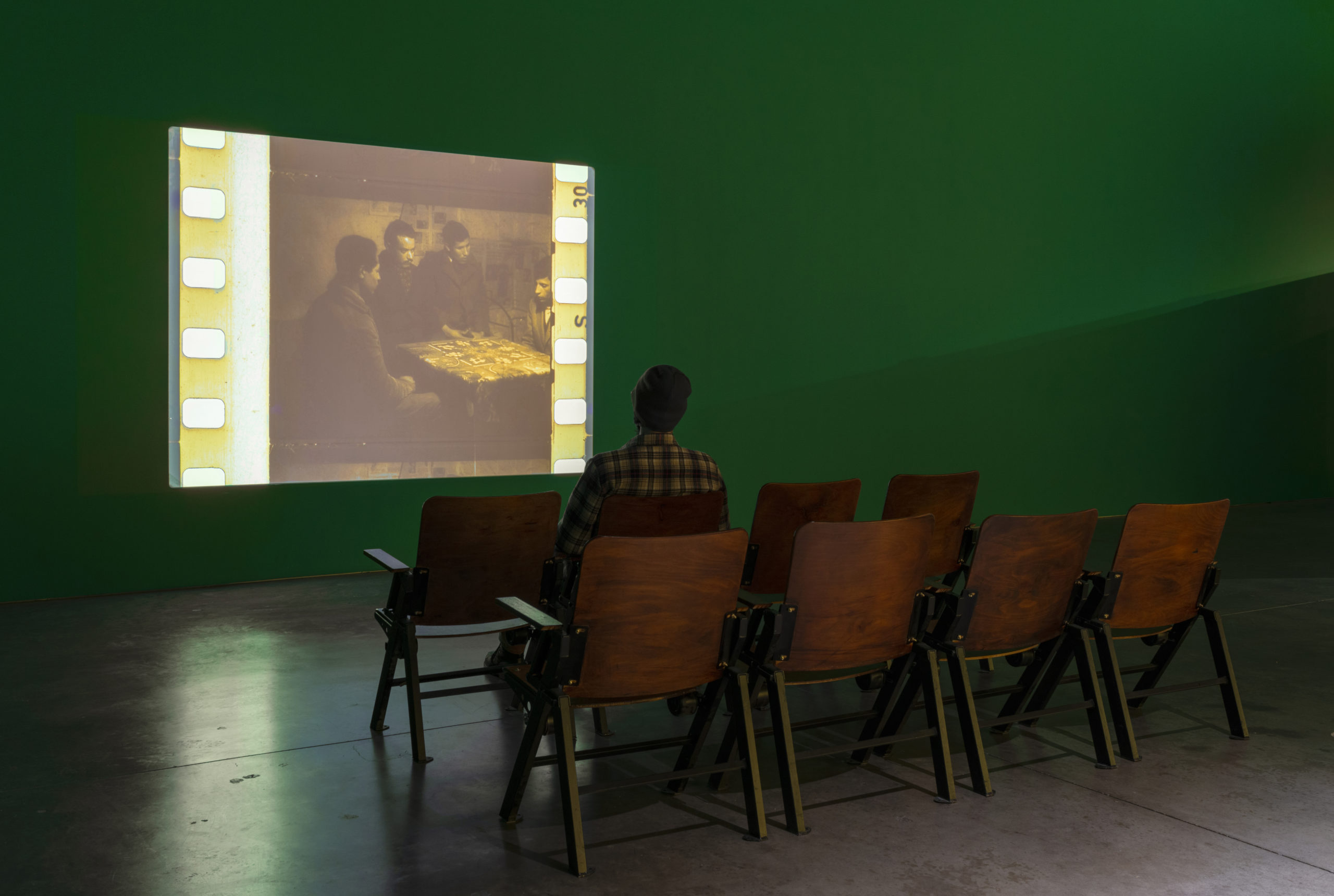Talking Back: Zineb Sedira’s Voice-Over
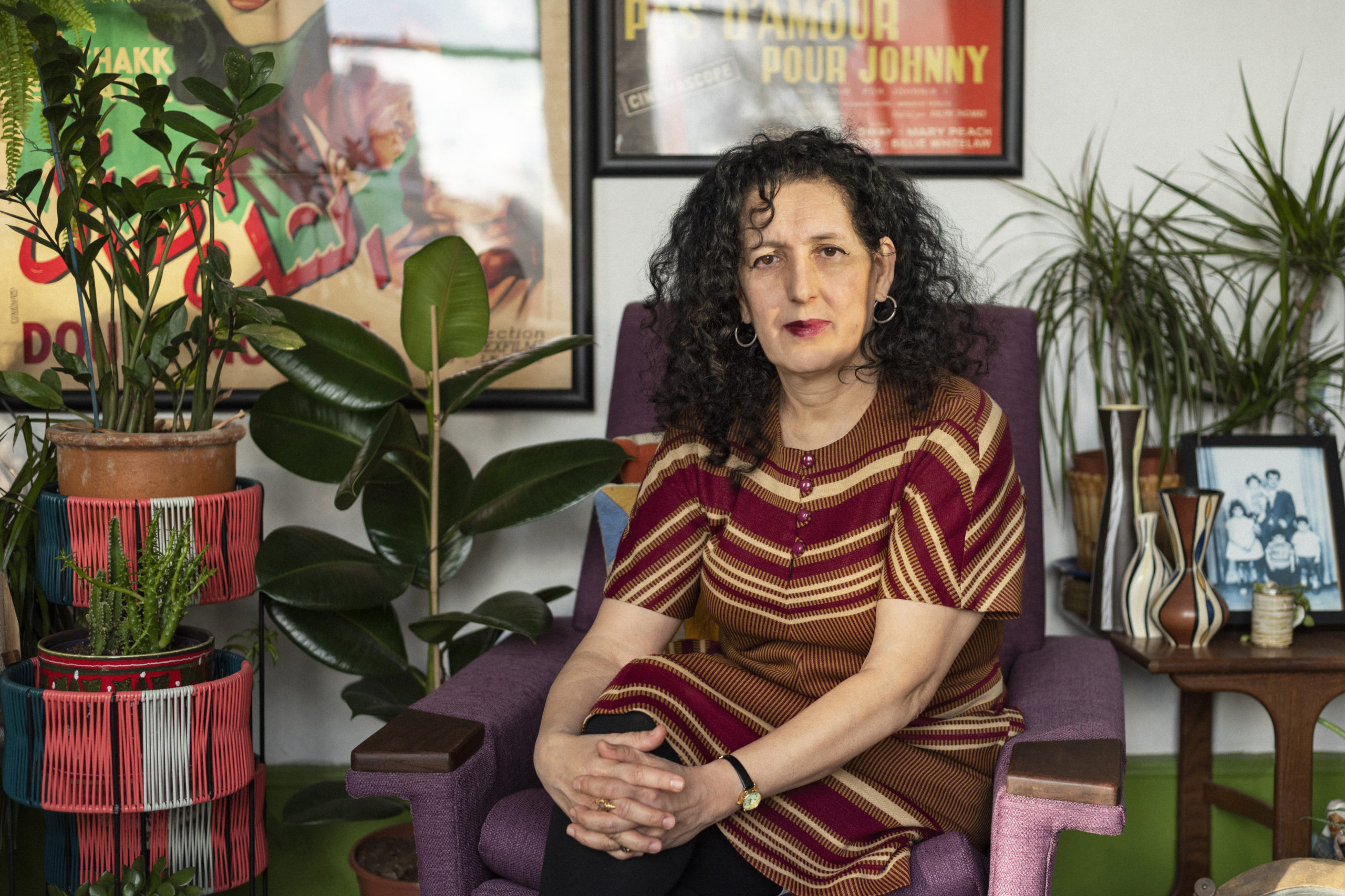
Zineb Sedira, 2021 [photo: Thierry Bal; courtesy of Scottsdale Museum of Contemporary Art, Scottsdale]
Share:
Projection walls of movie theaters are curved to correct for distortion. Images projected on them appear flat because of an optical trick; depth is conveyed by a suggestion embedded in form. The Scottsdale Museum of Contemporary Art was once a five-plex United Artists movie theater, and the architecture holds its history: The museum’s concave back wall curves around Zineb Sedira’s Voice-Over, the French-Algerian artist’s first solo museum exhibition in the United States.
Similarly, Sedira’s Way of Life (2021) casts an ersatz version of the artist’s living room in Brixton, England, to represent her personal archive. Made of wheat-pasted one-to-one scale photographs of the room’s walls, midcentury modern furniture, a collection of African sculptures and masks, and a television set playing a video of a friend, the replicated living room receives visitors as a stand-in—a surrogate gathering place during a period of collective isolation. The staged intimacy is reconsidered as both a private collection of objects and a theater for engagement, in which the personal can be manipulated, interacted with, and touched.
Zineb Sedira, Way of Life (Living Room), installation view, 2019, diorama [courtesy of Scottsdale Museum of Contemporary Art, Scottsdale]
In Mother Tongue (2002), Sedira positions her mother, who speaks Arabic; her daughter, who was born in London and speaks English; and herself, a native French speaker, as points demarcating generational changes in language. The resulting conversations, which are presented in a minimal video feed, are stilted, full of silence. Language, spoken without an anticipated response, hangs in an acutely heavy register. Sedira’s daughter seems despondent, equal parts bored and confused, as her mother responds in French to questions about going to school. The conversation is awkward, staged, but it manages to progress. When Sedira’s daughter is in conversation with the artist’s mother, however, speaking is just not possible.
“How old were you when you started doing things by yourself?” the granddaughter asks without facing her grandmother, who, in turn, looks toward the camera. Silently, she struggles to discern a semblance of meaning from her daughter, Sedira—who sits, partially obstructed, off screen. “Did you play with any friends?” Sedira’s daughter asks, in her British-accented English. Her grandmother repeats, “Friends,” without seeming to understand the word, her voice like a cave receiving the sound of her granddaughter’s voice and echoing it back. Between them, language doesn’t work.
Zineb Sedira, Mother Tongue, installation view, 2002, video, format 4:3, duration: 4 mins each screen [courtesy of Scottsdale Museum of Contemporary Art, Scottsdale]
In music, there is a meaningful communication that does not bend to the dividing lines made by national or colonial powers. Standing Here Wondering Which Way to Go (2021) is the central installation in Voice-Over. It is named for Marion Williams’ rendition of the eponymous song—a baritone gospel anthem with the power to instantaneously evoke the singer’s courage. The song is animated by hope encased in resolve, which transcends lyrics. Many words are broken up, anyway, by Willams’ incredible breath, by her ability to stretch sound out over a feeling. English, already, is not quite the medium she’s working with—it’s just a conveyance for the ethereal.
Williams performed this song in 1969 at The Algerian Pan-African Festival, the first gathering of its kind, which included performances by Archie Shepp, Nina Simone, Miriam Makeba; and speeches by Black Panther Eldridge Cleaver, Haitian poet and activist René Depestre, and many others. The state-sponsored celebration of music and culture took place just a few years after the nascent country won independence from France. It was considered part of the nation’s continued fight against imperialism and the legacy of colonialism. Houari Boumédiène, the chairman of Algeria’s Revolutionary Council, spoke candidly about the need for African countries to embrace their historical identities to dislodge the ethnic violence imposed by French occupation.
Zineb Sedira, For A Brief Moment The World Was On Fire, installation view, 2019, color photomontages [courtesy of Scottsdale Museum of Contemporary Art, Scottsdale]
Working with collage, Sedira presents a cut-up homage to the festival that arranges spliced images and newspaper headlines digitally printed on hard plastic boards, an assortment of small objects, and a presentation of vintage record albums of music associated with the period. This maximalist visualization, titled For A Brief Moment the World Was on Fire … (2021), takes up an entire wall of the museum, bisecting the wall’s surface like a horizon-line. The reassembly creates a polyphonic visual layer that embeds the artist’s documentarian perspective into the festival’s representation. The collage undercuts the authority of the photographs and reminds the viewer that images are not evidentiary—but easily manipulated to present certain narratives.
At times the photo collage elements of the exhibition feel more didactic than evocative.
The distilled history does not quite break through the flat visual role in which it has been cast. The most blatantly personal, and intimate, inclusions in the collage are most successful in interrupting the notion of a fixed past. For example, Sedira rests her father’s actual travel visa used between France and Algeria against one of her photo collages. In the identification photo, he looks away from the camera, averting his gaze to the left. His eyes are wide, and he exudes a palpable discomfort. In The Exhausted Bodies of the Colonial Spectacle, a manifesto from the French collective Cases Rebelles, the group writes that a photograph summoning state violence is not something to be historicized, but rather a permanent entrapment. By including this image, Sedira brings an immediate need to unlearn colonialism into the room.
The first iteration of Standing Here Wondering Which Way to Go was shown at the Jeu de Paume in Paris. Although the work has been re-interpreted for its American debut, including slight modifications, the exhibition is at odds with its southwestern context. In Scottsdale, a wealthy suburb of Phoenix that drips with put-on Americana, it is difficult to view the show without considering the United States’ history of systemic violence, both domestically and through imperial actions.
Almost the same time as the Algerian Pan-African Festival was taking place, 40,000 or so people in New York gathered for the Harlem Cultural Festival, where such musicians as Stevie Wonder, Sly and the Family Stone, Mahalia Jackson, and Nina Simone were playing to a primarily Black crowd. This event was recently made widely accessible by Summer of Soul (…Or, When The Revolution Could Not Be Televised), a documentary by musician and writer Questlove that presents rarely seen archival footage of the festival. Just a day before the festival in Algiers, and in the midst of the Harlem Cultural Festival, the Apollo 11 moon landing took place. In Summer of Soul, an incredible sequence of interviews with festival participants contextualizes the historical event, as person after person dismisses the supposed national success as yet another costly and futile demonstration of American imperial might. “I couldn’t care less,” says a young man pulled aside and questioned by a television broadcaster. “The cash they wasted getting to the moon could have been used to feed poor Black people in Harlem, and all over the place.”
Zineb Sedira, End of the Road, installation view, 2010, Two-screen projection with sound, shot on super 16mm film, format 16:9, duration: 15 minutes [courtesy of Scottsdale Museum of Contemporary Art, Scottsdale]
The American state’s priorities in 1969 were clear. The Harlem Cultural Festival was tacitly allowed, but the country’s main focus was neocolonial expansion. This contrast underscores the unique moment presented by the Algerian Pan-African Festival. It’s rare that a state-sponsored cultural event is also truly radical, and difficult to imagine such a thing in the US, where public arts funding, no matter how well intended, required a participation in the American imperial project. When Algeria freed itself from French occupation, the creation of a state history became tantamount to unworking the violent assimilation forced upon Algerians. Public space had to be created for the young country to develop a sense of identity. Meeting, talking, dancing, and sharing in that nationally defined public—perhaps through a festival—became a way to establish a new history and a new cultural archive for that space. In Standing Here Wondering Which Way to Go, Sedira reintroduces this sentiment by staging an oral history of this moment and inviting present, active conversation about the ongoing historical wake left by colonialism.
In 1965, Algeria was one of the first countries in Africa to establish a national cinematheque. In the same vein as the cultural festival, it was seen as part of the country’s larger anticolonial and anticapitalist commitments. Through the cinematheque, the state funded dozens of Algerian filmmakers who couldn’t finance their work otherwise. It also invited European directors to come to Algeria and make films with state support—most notably, it partially financed Gillo Pontecorvo’s The Battle of Algiers. During a visit to the national film archives, Sedira spent time among millions of canisters of film—in the material presence of the national cultural productions. In a conversation with the show’s curator, Natasha Boas, Sedira recounts that after leaving the archive, she happened upon a flea market. One seller had a canister full of bits of broken and decaying film strips that he told the artist were from a former projectionist at the cinema of Algiers. She bought the canister, which was damaged by time, and began the work of “trying to give it more visibility.”
For mise-en-scène (2021), Sedira scanned the film stock, its state of decay notwithstanding, and then stitched together a new sequence. Consisting primarily of Algerian films from the 60s and 70s, the distorted film stock undulates through colors and levels of opacity, sometimes so damaged by time that the picture is nothing more than varying densities of light. The visual effect is reminiscent of oil paintings by Bracha Ettinger, a Lacanian philosopher and artist. The images are layered over, inscribed with a sense of loss. In her work, Ettinger layers photographs with a tissued, soft obstruction made from semi-opaque oils. These layers represent the historical document and shield the individual—standing in for a larger history—from the gaze of the present.
Zineb Sedira, Mise En Scene, installation view, 2019, video, format 4:3, duration: 8:59 [courtesy of Scottsdale Museum of Contemporary Art, Scottsdale]
Fragmented clips of opening titles in dramatic films, panoramic shots, encounters in homes, and stock imagery, sutured together and placed in fabricated proximity, become a visual abstraction representative of the film archives. “Memory is not unilinear at all,” writes John Berger. “[It] works radially, that is to say with an enormous number of associations all leading to the same event.” The apparatus through which the strips of film are being projected is underscored by the inconsistent frame of their material stock. They compose a collective image from nonlinear associations.
Throughout Voice-Over, historical archives are opened and handled as intimate assemblies. The exhibition intersplices Sedira’s personal experiences with histories of colonialism, immigration, and displacement to weave an intimate thread through national mythologies. Speaking about her practice as “telling over,” Sedira asserts her voice as an annotative presence in the historical materials with which she works. Even as this exhibition addresses colonial struggle and African diaspora, space and the way it is narrated are in implicit contestation. From the repurposed remnants of a movie theater in Scottsdale, AZ, in a tromp-l’œil Brixton living room, Sedira hopes to liberate history from its confinement to the past.
Theadora Walsh is a writer based in Los Angeles who makes moving texts, essays, and fragments. Her writing has been published in Artforum, SFMoMA’s Open Space, The Los Angeles Review of Books, Art in America , and elsewhere.
